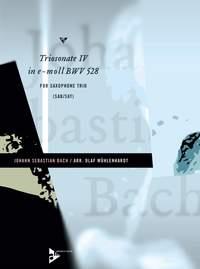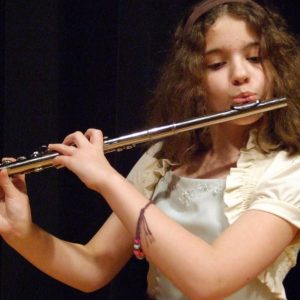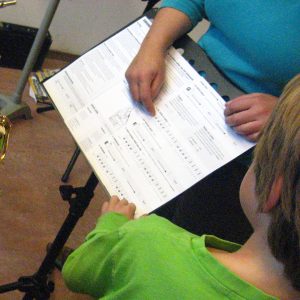Bach: Triosonate IV in e-moll BWV 528

- Componist:Bach, Johann Sebastian
- Uitgever:Advance Music
- Instrument(en): Altsaxofoon, Tenorsaxofoon, Baritonsaxofoon
- Periode: Barok
- Arrangeur: Mühlenhardt, Olaf
- Bezetting: Saxofoon Trio
- Genre: Klassiek
- Soort: Set (Partituur, Losse Partijen)
- Moeilijkheidsgraad: Gevorderd
- Uitgeversnummer: ADV 7705
- ISBN: 9790206301179
- ISMN: 979-0-2063-0117-9
Prijs € 20,70
Wensenlijst
Wensenlijst
Bel voor advies: 0342-419197
Informatie
Bach composed the six Trio Sonatas for Organ BWV 525 - 530 probably between 1727 and 1730 when he was Cantor at the St. Thomas Church in Leipzig. The trio sonata as a baroque genre usually employs four players: two solo parts (violin, flute or oboe), a bass part (Cello, violone or bassoon) and the continuo part (organ, harpsichord or lute). It is assumed that during his time in Köthen (1717 - 1723), Bach composed a few dozen trio sonatas for various instruments, of which very few have survived. In fact, the Triosonata for two Fluit and Continuo BWV 1039, along with the one from the Musical Offering (which was written much later), is the only one of which the authenticity can be regarded as certain. Bach arranged it for Viola da Gamba and harpsichord (BWV 1027). The upper solo part is played by the right hand of the harpsichordist while the Viola plays the second part an octave lower. Later, Bach arranged the last movement for organ (Trio in G). Here, the pedal plays a slightly simplified bass, and the left hand takes up the second part. Maybe some of the movements of the six Trio Sonatas for Organ go back to lost compositions Bach has arranged in a similar manner. There are earlier versions of many movements, and the original of at least one movement (BWV 528, I.) was written for more than one instrument: the Sinfonia of the second part of Cantata BWV 76 which is set for Oboe d'amore, Viola da Gamba and Basso Continuo. The linear, distinctly chamber music-like disposition of the Sonatas further supports this assumption, and a number of recent recordings of the Sonatas with two solo instruments and basso continuo convincingly justify the reconstruction of a hypothetical original. The first movement has an unusual form. It begins with a slow introduction - a three-part fugue exposition, with a theme apparently resembling that of the second movement. The Vivace starts on the second eighth in bar 5 and is relatively short, compared to the other sonatas. Its melodic lines are particularly driving and energetic. The fugue theme is answered in the octave, which Bach typically does in slower movements. In the Andante, a two-bar phrasing is particulary noticeable. In the first section (bars 1 - 11) the theme is answered in unison, and after a two-bar interlude the theme appears in the dominant. In the second section (bars 11 - 23) the two solo parts develop motifs from the main theme in a beautiful dialogue. The first section is repeated in e-minor without bars 1 - 7. It is followed by the second section, here shifting to G-major. While the bass has almost exclusively served as an accompaniment so far, it is actively involved in the development of the fugue theme in the last movement, Un poc' allegro. It is dominated by a large variety of bubbly triplet figures. The form can either be perceived in three large sections (I. m 1 - 28, II. m 28 - 60, III. m 60 - 87, coda) or as a fugue-rondo with regular theme appearances. Due to the range and for better playability the sonata was transposed a halfstep above the original key. The slurs comply with the Neue Bach Ausgabe. In the manuscripts their beginnings and ends are usually difficult or impossible to determine. Suggestions are printed in dashed slurs. In the second movement the Soprano and Alto parts were exchanged in bar 38 - 40 to accomodate the Soprano's range. The dotted six-teenth notes in the third movement have to be adjusted to the triplet rhythm.Gerelateerde producten
- Telefonisch advies & bestellen
- 14 dagen bedenktijd
- Gratis retourneren
- Korting voor Docenten, koren of verenigingen
- Vanaf 30 euro = gratis verzenden
- Achteraf betalen













